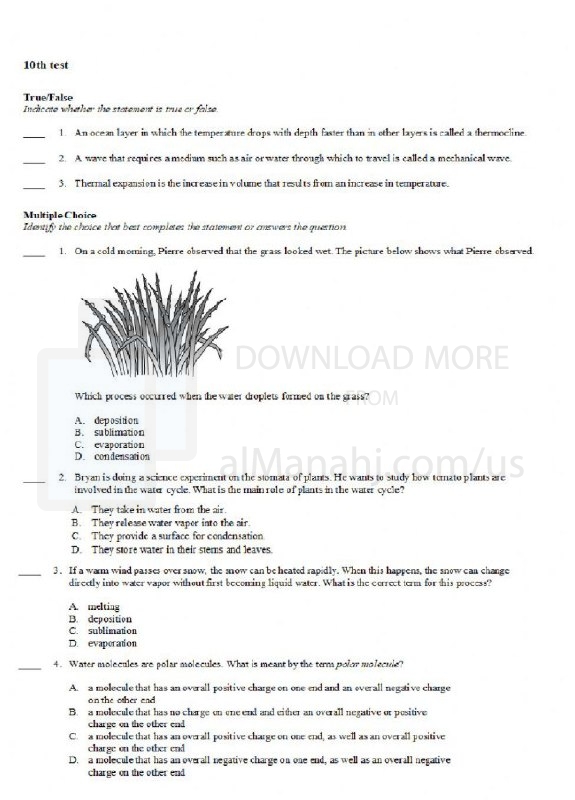| You are here: Almanahj Website ⇒ American curriculum ⇒ 10th Grade ⇒ Geology ⇒ Term 1 | ||
|---|---|---|
Worksheet about Water cycle | ||
|---|---|---|
| Subject: Geology | ||
| 10th Grade | ||
| Term 1 | ||
| Year: 2023/2024 | ||
| Size: 473.2KB | ||
| Number of clicks: 95 | ||
| Publish date:November 29, 2023 | ||
| Added by: Eman | ||
| Last download date: 2024-09-11 12:27:01 | By: theodor Ana Infante | |
| File info: The water cycle, also known as the hydrological cycle, is the continuous movement and cycling of water on Earth. It involves the processes of evaporation, condensation, precipitation, runoff, and infiltration. The water cycle is driven by the energy from the Sun and the force of gravity. Here are the main stages of the water cycle: 1. Evaporation: Evaporation is the process in which water changes from a liquid state to a gaseous state. It occurs when heat energy from the Sun causes water molecules to gain enough energy to escape from the surface of bodies of water, such as oceans, lakes, rivers, and even moist soil. Transpiration, which is the release of water vapor from plants, also contributes to evaporation. 2. Condensation: When water vapor rises into the atmosphere, it cools and undergoes condensation. Condensation is the process by which water vapor transforms into liquid water droplets. It occurs around tiny particles in the air, such as dust, pollutants, or microscopic ice crystals, to form clouds. 3. Precipitation: Precipitation is the process by which water falls from the atmosphere to the Earth's surface in various forms, such as rain, snow, sleet, or hail. Precipitation occurs when the condensed water droplets in clouds combine and become too heavy to remain suspended in the air. Gravity pulls the droplets down, and they precipitate onto the land or bodies of water. 4. Runoff: When precipitation reaches the Earth's surface, it can flow over the land as runoff. Runoff occurs when the ground is saturated, or when the precipitation falls too quickly for the soil to absorb it. Runoff collects in streams, rivers, and eventually flows into larger bodies of water, such as lakes or oceans. It plays a crucial role in transporting water and nutrients across the landscape. 5. Infiltration: Infiltration refers to the process of water seeping into the ground and replenishing groundwater. When precipitation falls onto the land, some of it is absorbed by the soil and underlying rocks. This water percolates downward through the soil layers, filling the spaces between particles and recharging underground aquifers. 6. Transpiration: Transpiration is the process by which plants absorb water from the soil through their roots and release it into the atmosphere as water vapor through their leaves. It is an essential part of the water cycle as it contributes to the overall moisture in the atmosphere. The water cycle is a continuous and interconnected process, where water moves between the atmosphere, land, and water bodies. It plays a vital role in regulating Earth's climate, distributing freshwater resources, and sustaining life on the planet. Human activities, such as water extraction, deforestation, and climate change, can affect the water cycle and have implications for water availability, ecosystems, and the environment. | ||
| Downloading link Worksheet about Water cycle |
|---|
|
1701248047.pdf
The file is being prepared for download
|
| File images |
|---|
 |